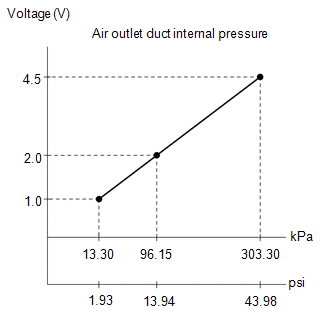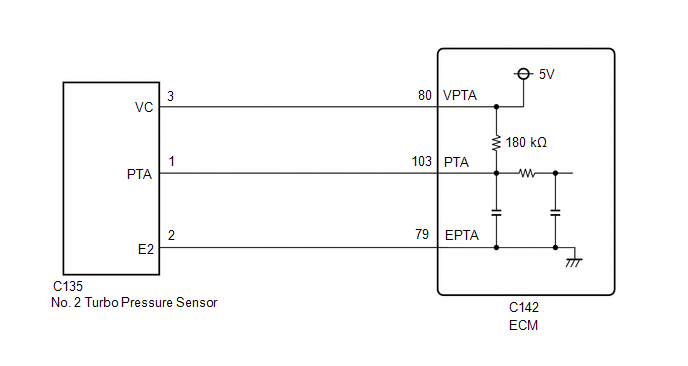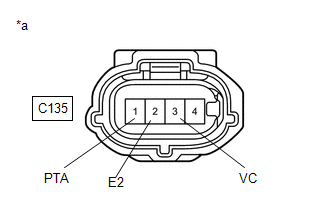- Short in PTA circuit to ground
- Short in PTA circuit to EPR circuit
- Open in VCPR circuit
| Last Modified: 05-13-2024 | 6.11:8.1.0 | Doc ID: RM10000000255TH |
| Model Year Start: 2023 | Model: GR Corolla | Prod Date Range: [09/2022 - ] |
| Title: G16E-GTS (ENGINE CONTROL): SFI SYSTEM: P023511; Turbocharger/Supercharger Boost Sensor "A" Circuit Short to Ground; 2023 - 2025 MY GR Corolla [09/2022 - ] | ||
|
DTC |
P023511 |
Turbocharger/Supercharger Boost Sensor "A" Circuit Short to Ground |
DESCRIPTION
The internal sensor in the No. 2 turbo pressure sensor detects the air outlet duct internal pressure as a voltage.

|
DTC No. |
Detection Item |
DTC Detection Condition |
Trouble Area |
MIL |
Note |
|---|---|---|---|---|---|
|
P023511 |
Turbocharger/Supercharger Boost Sensor "A" Circuit Short to Ground |
The output voltage from the No. 2 turbo pressure sensor is below 0.84 V for 3 seconds or more (1 trip detection logic). |
|
Comes on |
SAE Code: P0237 |
HINT:
When a DTC is output, check the Data List item "Boost Pressure Sensor" using the GTS.
|
DTC No. |
Boost Pressure Sensor |
Malfunction |
|---|---|---|
|
P023511 |
Approximately 0 kPa [0 psi] |
|
If the Data List displays a normal value, the normal value may be due to a temporary recovery from the malfunction condition. Check for intermittent problems.
MONITOR DESCRIPTION
The ECM calculates the air outlet duct internal pressure from the No.2 turbo pressure sensor output voltage. If the No. 2 turbo pressure sensor output voltage is not within the normal range, there may be a malfunction in the No. 2 turbo pressure sensor or an open or short circuit. In this case, the ECM illuminates the MIL and stores a DTC.
Example:
When the sensor output voltage is below 0.84 V for 3 seconds or more, the ECM stores a DTC.
MONITOR STRATEGY
|
Related DTCs |
P0237: No. 2 turbo pressure sensor range check (low voltage) |
|
Required Sensors/Components (Main) |
No. 2 turbo pressure sensor |
|
Required Sensors/Components (Related) |
- |
|
Frequency of Operation |
Continuous |
|
Duration |
3 seconds |
|
MIL Operation |
Immediate |
|
Sequence of Operation |
None |
TYPICAL ENABLING CONDITIONS
|
Monitor runs whenever the following DTCs are not stored |
None |
|
All of the following conditions are met |
- |
|
Battery voltage |
8 V or higher |
|
Ignition switch |
ON |
|
Starter |
Off |
TYPICAL MALFUNCTION THRESHOLDS
|
No. 2 turbo pressure sensor voltage |
Below 0.84 V (Below 0 kPa [0 psi]) |
CONFIRMATION DRIVING PATTERN
HINT:
- Connect the GTS to the DLC3.
- Turn the ignition switch to ON and turn the GTS on.
- Clear the DTCs (even if no DTCs are stored, perform the clear DTC procedure).
- Turn the ignition switch off and wait for at least 30 seconds.
- Turn the ignition switch to ON [A].
- Turn the GTS on.
- Start the engine and wait 5 seconds or more [B].
- Enter the following menus: Powertrain / Engine / Trouble Codes [C].
-
Read the pending DTCs.
HINT:
- If a pending DTC is output, the system is malfunctioning.
- If a pending DTC is not output, perform the following procedure.
- Enter the following menus: Powertrain / Engine / Utility / All Readiness.
- Input the DTC: P023511.
-
Check the DTC judgment result.
GTS Display
Description
NORMAL
- DTC judgment completed
- System normal
ABNORMAL
- DTC judgment completed
- System abnormal
INCOMPLETE
- DTC judgment not completed
- Perform driving pattern after confirming DTC enabling conditions
HINT:
- If the judgment result shows NORMAL, the system is normal.
- If the judgment result shows ABNORMAL, the system has a malfunction.
-
[A] to [C]: Normal judgment procedure.
The normal judgment procedure is used to complete DTC judgment and also used when clearing permanent DTCs.
- When clearing the permanent DTCs, do not disconnect the cable from the battery terminal or attempt to clear the DTCs during this procedure, as doing so will clear the universal trip and normal judgment histories.
WIRING DIAGRAM

CAUTION / NOTICE / HINT
HINT:
Read Freeze Frame Data using the GTS. The ECM records vehicle and driving condition information as Freeze Frame Data the moment a DTC is stored. When troubleshooting, Freeze Frame Data can help determine if the vehicle was moving or stationary, if the engine was warmed up or not, if the air fuel ratio was lean or rich, and other data from the time the malfunction occurred.
PROCEDURE
|
1. |
CHECK HARNESS AND CONNECTOR |
HINT:
Make sure that the connector is properly connected. If it is not, securely connect it and check for DTCs again.
(a) Disconnect the No. 2 turbo pressure sensor connector.
(b) Turn the ignition switch to ON.
|
(c) Measure the voltage according to the value(s) in the table below. Standard Voltage:
|
|
(d) Turn the ignition switch off and wait for at least 30 seconds.
(e) Measure the resistance according to the value(s) in the table below.
Standard Resistance:
|
Tester Connection |
Condition |
Specified Condition |
|---|---|---|
|
C135-3(VC) - C135-1(PTA) |
Ignition switch off |
171 to 189 kΩ |
| OK |

|
|
|
2. |
CHECK HARNESS AND CONNECTOR (NO. 2 TURBO PRESSURE SENSOR - ECM) |
(a) Disconnect the No. 2 turbo pressure sensor connector.
(b) Disconnect the ECM connector.
(c) Measure the resistance according to the value(s) in the table below.
Standard Resistance:
|
Tester Connection |
Condition |
Specified Condition |
|---|---|---|
|
C135-3(VC) - C142-80(VPTA) |
Always |
Below 1 Ω |
|
C135-3(VC) or C142-80(VPTA) - Body ground and other terminals |
Always |
10 kΩ or higher |
| OK |

|
| NG |

|
REPAIR OR REPLACE HARNESS OR CONNECTOR |
|
|
|
![2023 - 2025 MY GR Corolla [09/2022 - ]; G16E-GTS (ENGINE CONTROL): SFI SYSTEM: DATA LIST / ACTIVE TEST](/t3Portal/stylegraphics/info.gif)

